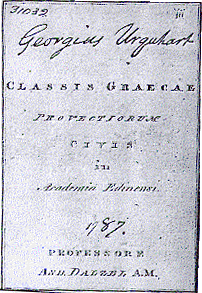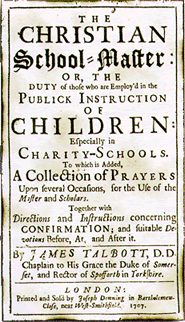Education
- Charity schools
- The S.P.C.K.
- Schools of industry
- Sunday schools
- Women’s education
- Education in Bath
- Education in Edinburgh
Charity schools

- Classis Graecae
- [click on the picture to enlarge it]
The first decades of the eighteenth century saw the foundation of numerous ’charity schools’ intended to provide elementary instruction for poor children, under the patronage of a federative organization, the S.P.C.K. Such instruction was supposed to carefully prepare pupils to start working in the inferior role that had been alloted to them by Providence. Which is why it was important to get them into habits of industry, cleanliness, respect of order and punctuality from an early age.
Learning to read allowed them to find these precepts in the Bible, in the Anglican catechism, and in pious works. If they also knew how to write and count, they could be taken into service all the more favourably. The avowed aim of the charity schools was therefore to maintain social order, to fight against juvenile delinquency and to instil work ethics.
Finance for such establishments came either from legacies, endowments or from voluntary subscriptions. This latter, more innovative, means of resource allowed members of the middle class, who would not have been able to endow the foundation individually, to group together in order to contribute to a good cause.
During the first three decades of the century, charity schools had to defend themselves against scathing criticism, the most famous of which appears in the second edition of La Fable des Abeilles (The Fable of the Bees) by Bernard Mandeville. The main reproach directed at the charity schools was that they encouraged social mobility.
The Society for Promoting Christian Knowledge

- The Society for Promoting Christian Knowled
- [click on the picture to enlarge it]
The Society for Promoting Christian Knowledge was formed in 1698 by four Anglican laymen and one clergymen in order to combat the “gross ignorance of the Christian religion” which they considered as responsible for “the growth of vice and immorality” in the nation. The main method was the printing and distribution of Christian literature, and the education or poor children in charity-schools.
Indeed, the Society provided advice and encouragement to local groups that wished to set up schools for boys and girls. It circulated manuals for schoolmasters , and textbooks for their pupils to learn basic literacy, numeracy and Christian doctrine. Such literature was distributed through a network of 370 corresponding members all over the country (between three and five in each county).
Although the Society did indeed act as a catalyst for the spectacular growth of charity schools in seventeenth-century England, and promulgated a curriculum that was widely used, historians are now reluctant to speak of a charity-school “movement”, in so far as many such schools were set up without reference to the S.P.C.K. model.
The Society also compiled reports on Christian education in workhouses.
Three centuries later, the S.P.C.K. remains a major publisher and distributor of Christian literature in the English-speaking world.
Schools of industry
From the first years of the eighteenth century, the idea of putting children to work seemed to have brought improvements to the instruction offered by charity schools and to have remedied what had been the object of criticism.
Taken to extremes, this principle encouraged the creation of schools of industry, where manual work became the main activity, and consequently general instruction was reduced.
Sunday schools
The development of Sunday schools started towards the end of the century. They offered an even more rudimentary form of instruction than the program proposed by the charity schools, although they shared in part the same objectives, which were to teach catechism, reading and social discipline.
As children were only in school on Sundays, nothing prevented them from working during the rest of the week. No doubt, it is not by chance that this movement came into existence during the period that is commonly called the Industrial Revolution.
The reduction in the volume of weekly instruction, of course, led to the diminishment of the syllabus and to an increase in the number of pupils, all the more so because there was no selection for entry.
However, the Sunday schools had to defend themselves against the same criticism as the charity schools half a century earlier. Essentially, they were reproached with encouraging social mobility. A noteworthy reply to this objection was the prediction that illiteracy would be eliminated.
It would, however, be necessary to wait a few decades before the fulfilment of this prediction. It is generally estimated that it was only after 1830, when the number of pupils exceeded the million mark, that all the children from the laboring classes could attend Sunday schools and that there was a significant effect on society.
Women’s education
click on the thumbnail to open the pdf document:
Education in Bath
Education in Edinburgh


